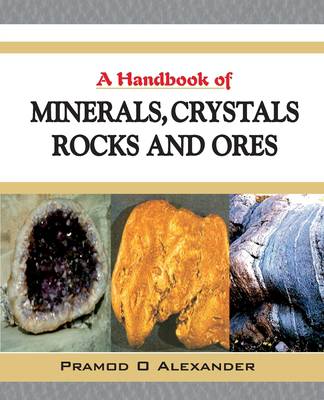
- Retrait gratuit dans votre magasin Club
- 7.000.000 titres dans notre catalogue
- Payer en toute sécurité
- Toujours un magasin près de chez vous
- Retrait gratuit dans votre magasin Club
- 7.000.0000 titres dans notre catalogue
- Payer en toute sécurité
- Toujours un magasin près de chez vous
112,95 €
+ 225 points
Format
Description
The book is divided into four sections, minerals, crystals, rocks and ores. Section A incorporates nine s, begins with presenting salient features of the earth--its structure and composition. The second Minerals and Mineralogy briefly tells about their diversity and their categorisation and introduces the interesting way they are named. Crystal chemistry the third is the heart and soul of mineralogy and deals in somewhat details about the building blocks of minerals -atoms and ions and the way they form diverse types of minerals are. It tries to tell why every combination of chemical compounds cannot result into a naturally occurring mineral. The fourth and fifth s deal with Properties of Minerals, physical and optical. The s describe various physical properties that are helpful in the identification both in hand specimens and as thin section under the microscope. These two s are adequately aided with a number of illustrations, photographs and photomicrographs to bring home the point. five deals with classification of minerals and their occurrence and forms a prelude to the next two s on descriptive mineralogy. Important silicate and non silicate minerals are described in s eight and nine. A brief description of mineral uses is dealt with in both descriptive mineralogy as well Section D on mineral deposits, however, the last, Mineral uses presents an overall picture and will be interesting as well as educating to students and even general readeSection B is devoted to crystals and crystallography. one introduces the subject while two presents basic crystallographic elements. three deals with the main six crystals systems while also giving a preliminary idea about stereographic projection and x-ray crystallography. Section C covers petrology, beginning with introduction to science of petrology, rock nomenclature. two is devoted to the study of igneous rocks, including their forms, composition, textures, structures, classification and description. Sedimentary rocks is the theme of three while different aspects of metamorphic rocks including kinds and agents of metamorphism and classification and description of metamorphism. The last portion of this also considers metamorphism in the background of global tectonics. five, the rock cycle presents a concise summary of geological events that have shaped the planet earth. The last section D is what geology is all about for a man on the street and its significance in nation building--the Ore minerals. It begins with what ore is and its place in human affairs as a well as presenting the important terminology in economic geology. two deals with ore genesis and presents various hypogene and supergene process that carves out ore deposits from non economic materials. three, mineral deposits and global tectonics is becoming a very popular theme among the earth scientists. A brief introduction of the same will be certainly appreciated by the student community and prompt them for further study in this direction. A general survey of India's mineral resources is the theme of four. It covers almost all of the commonly used ores, metallic, non metallic or fuels. The last of section D and the boom, 'Indian mineral industry: some facts and figures' will present where our country stands in the realm of mineral resources. Latest available data of resources, production, export, import, organisations that matter and other useful facts and figures are presented.
Spécifications
Parties prenantes
- Auteur(s) :
- Editeur:
Contenu
- Nombre de pages :
- 724
- Langue:
- Anglais
Caractéristiques
- EAN:
- 9788196046255
- Date de parution :
- 27-01-23
- Format:
- Livre broché
- Format numérique:
- Trade paperback (VS)
- Dimensions :
- 190 mm x 235 mm
- Poids :
- 1651 g

Les avis
Nous publions uniquement les avis qui respectent les conditions requises. Consultez nos conditions pour les avis.






